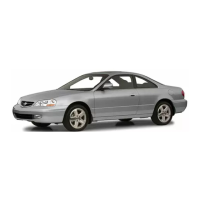
Do you have a question about the Acura 2001 CL and is the answer not in the manual?
| Brand | Acura |
|---|---|
| Model | 2001 CL |
| Category | Automobile |
| Language | English |
Key safety recommendations for safe driving and occupant protection.
Instructions for proper protection of adult occupants in the vehicle.
Guidelines for safely restraining infants and children in the vehicle.
Detailed information on seat belt system components and maintenance.
Explanation of front airbag system components and operation.
Details on side airbag system components and operation.
Information on the dangers and prevention of carbon monoxide exposure.
Locations and warnings of safety labels on the vehicle.
Explanation of the instrument panel gauges and their readings.
Information on car keys, immobilizer system, and door lock operation.
Instructions for adjusting driver and passenger seats for comfort and safety.
How to adjust interior and exterior mirrors for optimal visibility.
Storing and recalling preferred driving positions for seats and mirrors.
Operation of the electrically powered windows, including safety features.
Information on applying the parking brake and setting the digital clock.
Operation of ceiling lights, spotlights, and courtesy lights.
Operation of the AM/FM radio, cassette, and CD changer systems.
How to find radio stations using TUNE, SEEK, SCAN, and preset buttons.
Instructions for cleaning and maintaining the cassette player.
Loading, playing, and managing CDs in the multi-disc changer.
Using steering wheel controls to operate the audio system functions.
How the security system protects the car from theft and vandalism.
Requirements for gasoline type, octane, and oxygenated fuels.
Steps for refueling, opening the hood, and checking fluids at a service station.
How to check the engine oil level and what to do if it's low.
Warnings and advice on installing aftermarket accessories and making modifications.
Information on safe storage of cargo in various car areas and load limits.
Daily checks and adjustments to ensure safe operation before driving.
Procedures for starting the engine, including cold weather and high altitude.
Operation of the five-speed automatic transmission and Sequential SportShift mode.
Explanation of the disc brake system, wear indicators, and anti-lock brakes.
How the Traction Control System assists in maintaining traction on slippery surfaces.
How the VSA system enhances vehicle stability and traction during cornering.
Driving techniques and precautions for rain, fog, and snow conditions.
Guidelines and equipment for safely towing a trailer.
Essential safety precautions and guidelines for performing vehicle maintenance.
Recommended service intervals for normal and severe driving conditions.
Regular checks owners can perform on fluid levels, tires, and lights.
Diagrams showing the location of engine oil, coolant, brake fluid, etc.
Information on adding, recommended types, and changing engine oil and filter.
How to check and add engine coolant, and replace coolant.
Information on tire inflation, inspection, maintenance, rotation, and replacement.
Checking operation of exterior lights and replacing bulbs.
Procedures for preparing the car for extended storage.
Guidelines for washing, waxing, and cleaning the car's exterior.
How to clean and maintain the car's interior surfaces like carpeting and leather.
Measures to prevent and protect against car corrosion.
Advice on body repairs and their impact on corrosion resistance.
Precautions and limitations for using the compact spare tire.
Step-by-step guide for safely changing a flat tire.
Troubleshooting steps when the engine fails to start.
Correct procedure and safety precautions for jump-starting a dead battery.
Steps to take if the engine overheats, including safety warnings.
What to do if the low oil pressure warning light indicates a problem.
What the charging system indicator means and how to address it.
Understanding the check engine light and potential causes like a loose fuel cap.
What the brake system warning light signifies and how to react.
Location and procedure for checking and replacing vehicle fuses.
Types of towing equipment and procedures for safely transporting the vehicle.
Location of Vehicle Identification Number (VIN) and engine/transmission numbers.
Technical specifications for dimensions, weights, capacities, and fluids.
Explanation of tire grading for treadwear, traction, and temperature.
How the vehicle's emissions control systems work and are maintained.
Contact information and procedures for customer relations issues.
Overview of various warranty coverages for the vehicle and its components.
Procedure for reporting safety defects to NHTSA and Acura.
Information and order form for purchasing service and repair manuals.
